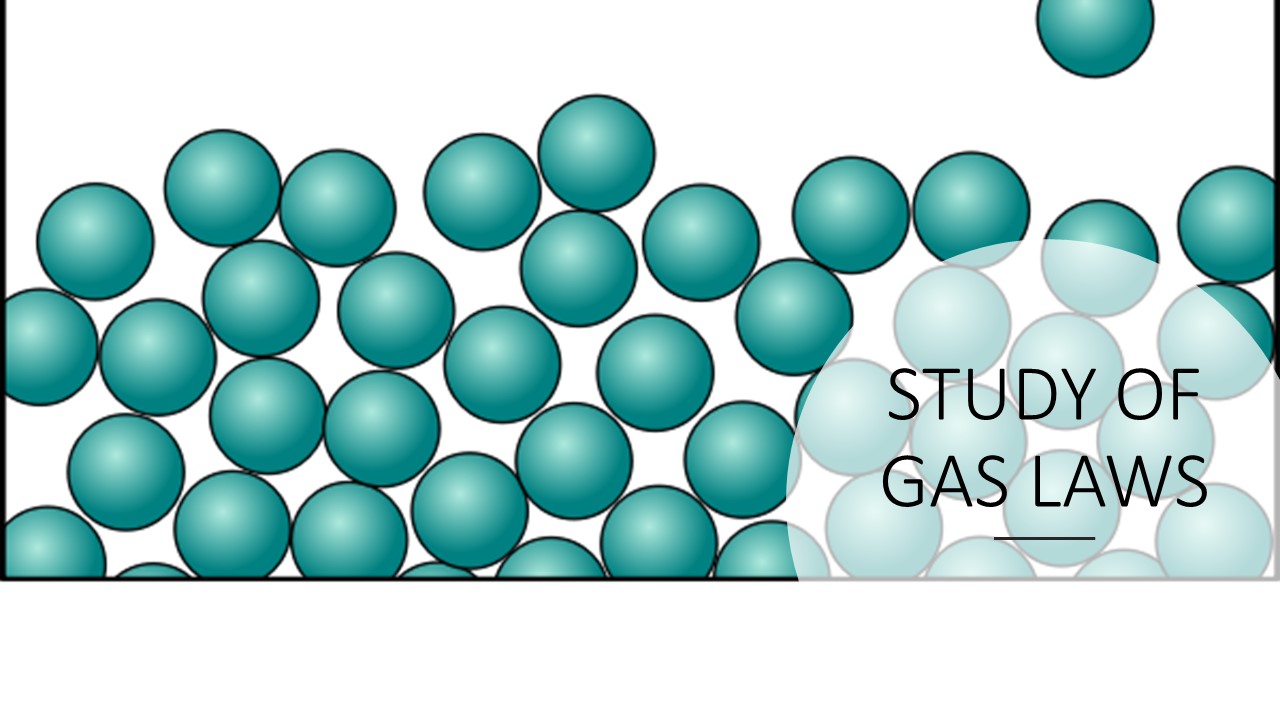STD IX – STUDY OF GAS LAWS – (Online)
About Course
In this section will learn the following chapters:
1.The behaviour of gases under changes of temperature and pressure
2.Boyle’s Law
3.Charles’ Law
4.Absolute zero Kelvin scale of temperature.
5.Gas equation
6.Relationship between Kelvin scale and Celsius Scale
7.Numericals
Last Updated:April 1, 2022
0(0 Ratings)
Share Course
Page Link
Share on social media

Description
The behavior of gases under changes of temperature and pressure
In order to understand the behaviour of gases at the molecular level, scientists developed a theoretical model called Kinetic Molecular Theory (KMT) or Microscopic Model of Gases.
The kinetic theory describes a gas as a large number of submicroscopic particles (atoms or molecules), all of which are in constant rapid motion that has randomness arising from their many collisions with each other and with the walls of the container.
Relation between Kelvin and Celsius scale
The primary difference between the centigrade, or Celsius, scale and the absolute, or Kelvin, the scale is in their respective starting points.
The Celsius scale sets the freezing point of pure water at sea level as 0, while 0 degrees Kelvin is absolute zero, the coldest temperature theoretically possible.
K = °C + 273
Standard temperature and Pressure
Since temperature and air pressure may vary from place to place it is necessary to have standard values of pressure and temperature for carrying out experimental procedures.
STP or Standard Temperature and Pressure are used when performing calculations on gases.
Example: Gas density. The standard temperature is 273 K (0° Celsius) and the standard pressure is 1 atm pressure. At STP, one mole of gas occupies 22.4 L of volume (molar volume).
Charles’ law (Remember it as CP – “Charles law – Pressure constant”)
Charles’ Law expresses the relationship between volume and temperature.
Pressure remaining a constant, the volume and absolute temperature of a certain quantity of a gas are directly proportional to each other.
Boyle’s law, also called Mariotte’s law – P
Boyle’s law, also called Mariotte’s law, a relation concerning the compression and expansion of a gas at constant temperature. This empirical relation, formulated by the physicist Robert Boyle in 1662, states that the pressure (p) of a given quantity of gas varies inversely with its volume (v) at constant temperature, i.e., in equation form, pv = k, a constant.
The law can be derived from the kinetic theory of gases assuming a perfect (ideal) gas (see perfect gas). Real gases obey Boyle’s law at sufficiently low pressures, although the product pv generally decreases slightly at higher pressures, where the gas begins to depart from ideal behaviour.
Free
Free
Free access this course
-
LevelIntermediate
-
Last UpdatedApril 1, 2022
-
CertificateYes
Hi, Welcome back!
Material Includes
-
Live Interactive classes with in-class doubt solving
-
Weekly Test and Quiz with instant tracking for progress
-
Revision of the course after testing
-
Fortnightly Parents and Tutor interactions
-
Expert monitoring of student's learning progress
-
Daily communication over call, whatsapp and mail
-
3 hours on-demand video
-
4 downloadable resources
-
Access for entire Academic Year
-
Access on mobile and Desktop
-
Assignments and review of the same
-
Tests and Correction by Board paper checkers
-
Certificate of completion and Live tracking with Grade book
Course Duration:
0
Course level:Intermediate
Enrolled:0
About Course
In this section will learn the following chapters:
1.The behaviour of gases under changes of temperature and pressure
2.Boyle’s Law
3.Charles’ Law
4.Absolute zero Kelvin scale of temperature.
5.Gas equation
6.Relationship between Kelvin scale and Celsius Scale
7.Numericals
Course Curriculum
GAS LAWS
-
QUIZ – STUDY OF GAS LAWS – INTRODUCTION
-
01:09
-
01:08
-
01:25
-
01:25
-
QUIZ – STUDY OF GAS LAWS – LETS RECALL
-
QUIZ – STUDY OF GAS LAWS – CHARLES’ LAW
-
QUIZ – STUDY OF GAS LAWS – BASIC UNDERSTANDING OF ALL LAWS
-
QUIZ – STUDY OF GAS LAWS – CHARLES’ LAW AND BOYLE’S LAW
STANDARD TEMPERATURE
-
02:12
-
QUIZ – STUDY OF GAS LAWS > INTRODUCTION
-
QUIZ – STUDY OF GAS LAWS > THE GAS LAWS
-
QUIZ – STUDY OF GAS LAWS > PRESSURE – VOLUME RELATIONSHIP : BOYLE’S LAW
Student Ratings & Reviews

No Review Yet

